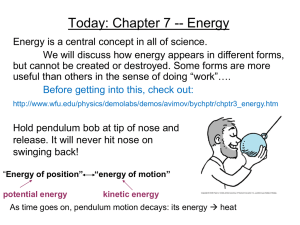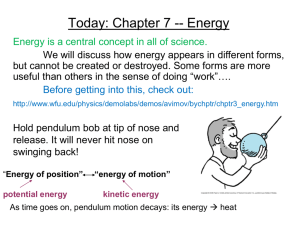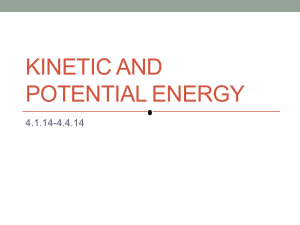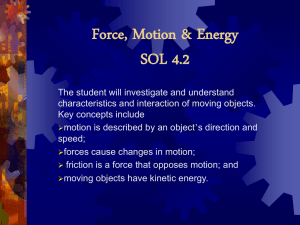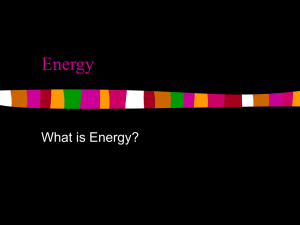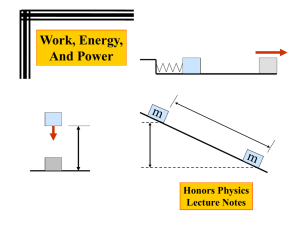Chapter 7: Energy
advertisement
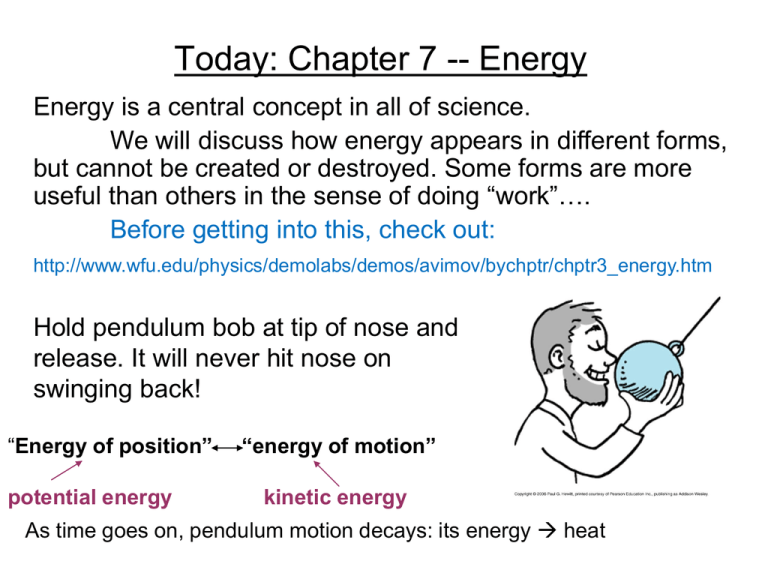
Today: Chapter 7 -- Energy Energy is a central concept in all of science. We will discuss how energy appears in different forms, but cannot be created or destroyed. Some forms are more useful than others in the sense of doing “work”…. Before getting into this, check out: http://www.wfu.edu/physics/demolabs/demos/avimov/bychptr/chptr3_energy.htm Hold pendulum bob at tip of nose and release. It will never hit nose on swinging back! “Energy of position” potential energy “energy of motion” kinetic energy As time goes on, pendulum motion decays: its energy heat Let’s start with closely related concept: Work Work = force x distance W = Fd ( c.f. Impulse, last class, which was force x time. A different measure of the “effectiveness” of the force) Note this may differ from everyday notion of what work is! Here, we speak of work done on an object. Eg. Weight-lifting If I lift a weight up above my head, I do work: I exert a force, moving the weight a distance = height. Lifting it twice as high, I do twice as much work. But if I am just holding the weight up above my head, I do zero work on the weight, as it is not moved (d=0). (I get tired due to work done on my muscles contracting and expanding, but no work is done on the weight) Clicker Question Power • Asks how fast is the work done i.e. Power = Work done time interval Eg. A tank of fuel can do a certain fixed amount of work, but the power produced when we burn it can be any amount, depending on how fast it is burned. It can run one small machine for longer time than a larger machine. Units: Work = Fd, so units are Newton x meter = Joule, J 1 J = 1 N.m Common for biological activity and food, is 1000 J = 1 kJ Power = Work/t, so units are Joule per second = Watt, W 1 kW = 1000 W and 1 MW = 1 000 000 W Eg. About 1 W of power is needed in vertically lifting a quarter-pound hamburger one meter in one second. See soon for how we got this… Mechanical Energy • When work is done on an object, energy is transferred to that object. This energy is what enables that object to then do work itself. Mechanical energy = potential energy + kinetic energy Energy due to relative position of interacting bodies Energy due to motion Potential Energy (PE) • A “stored energy” due to the configuration of the system (i.e. position of objects). System then has “potential” to do work. - A stretched or compressed spring, or rubber band – if attach an object on the end, it can move that object, so can do work on it. Egs. - Chemical energy in fuels, food etc, due to positions of the constituent atoms. When these atoms are rearranged (chemical process), energy becomes available. Potential Energy continued… • An important example: gravitational potential energy Work is required to raise objects against Earth’s gravity – this work is stored as gravitational PE. Eg. In some hydroelectric power plants, water is raised from a lower reservoir up to a higher one – so to a state of higher grav. PE. When electric energy is in demand, it is then released from high, PE transforms to motional (kinetic) energy and then electrical energy. Eg. Pendulum: when pull to one side, you are raising it against gravity, exerting a force and doing work on it, giving it grav. PE: • How much gravitational PE is stored when object is raised a height h ? Must equal the amount of work done in lifting it.: W = F.d , where F = mg, and d = h i.e. gravitational PE = mgh Eg. How much gravitational potential energy does a quarter-pound hamburger vertically raised 1 m have? Recall 1lb ~ 4.4 N and pound measures weight = mg grav. PE = mgh = ¼ (4.4N)(1m) = 1.1 J (recall 1-lb is about 4.4 N) So this is the work done in vertically lifting it 1m, and hence the power needed to do this in 1s is Power = W/t = 1.1 J/1s = 1.1 W (c.f earlier statement) Clicker Question PE = mgh • Important note! It doesn’t matter how the raise was done: The potential energy of the ball is the same at the top, in all three cases, because the total work done, W = Fd = mgh is the same whether lifted, pushed, or hopped up. (This assumes no force needed to move it horizontally – so neglecting friction) Another important note! h is defined relative to some reference level. Often we take that reference to be the ground. But we don’t need to – and if we don’t, the #’s we get for PE are different. That’s ok – PE doesn’t have absolute meaning. Only changes in it have meaning. When PE changes, the energy gets transformed to a different form (esp. motional) – the change has physically measurable consequences. Kinetic Energy (KE) • Is the energy of motion: KE = ½ mass x speed x speed i.e. KE = ½ m v 2 • KE depends on the reference frame in which it is measured (like the speed). e.g When you are sleeping, relative to your bed, you have zero KE. But relative to the sun, you have KE = ½ (your mass) (107 000 km/h)2 Work-Energy Theorem • When an object speeds up, its gain in KE comes from the work done on it: Work = D KE Net work Can be an increase (+) or decrease (-) in speed Eg. Pushing a table from rest. Its gain in KE = Fnet x distance, where Fnet = your force – friction. Only part of the work you do goes into KE of table, the rest goes into heat. Clicker Question Questions (1) A father pushes his child on a sled on level ice, a distance 5 m from rest, giving a final speed of 2 m/s. If the mass of the child and sled is 30 kg, how much work did he do? W = D KE = ½ m v2 = ½ (30 kg)(2)2 = 60 J (2) What is the average force he exerted on the child? W = F.d = 60 J, and d = 5 m, so F = 60/5 = 12 N More Questions (3) Consider a 1000-kg car going at 90 km/h. When the driver slams on the brakes, the road does work on the car through a backwarddirected friction force. How much work must this friction force do in order to stop the car? W = D KE = 0 - ½ m v2 = - ½ (1000 kg) (90 km/h)2 (1000 m/3600 s)2 = -312500 J = -312.5 kJ So W = 312.5 kJ (the – sign just means the work leads to a decrease in KE) Clicker Question Conservation of Energy Law • Kinetic and potential are two fundamental forms of energy; another is radiation, like light. Other (less fundamental) forms of energy: chemical, nuclear, sound… • Note that work is a way of transferring energy from one form to another, but itself is not a form of energy. • Energy cannot be created or destroyed; it may be transformed from one form into another, but the total amount of energy never changes. Energy is recycled between different forms. eg. Earlier pendulum example Eventually, pendulum stops, due to energy transformed to heat in air and string… Another example Eg. Dropping down from a pole. • As he dives, PE becomes KE. Always total energy constant. • If accounted for air resistance, then how would the numbers change? In presence of air, some energy gets transformed to heat (which is random motion of the air molecules). Total energy at any height would be PE + KE + heat, so at a given height, the KE would be less than in vacuum. PE would be the same for same height. • What happens to the energy when he hits the ground? Just before he hits ground, he has large KE (large speed). This gets transformed into heat energy of his hands and the ground on impact, sound, and energy associated with deformation . Clicker Question And another example: sun and then to earth.. • In the core of the sun, thermonuclear fusion occurs: due to gravity and very high temperature, hydrogen nuclei fuse together making helium nuclei, releasing lots of radiant energy. i.e potential + kinetic radiant energy. A small part of this radiation reaches the earth stored as chemical energy in plants, coal etc. kinetic energy, electric energy, etc… Recall hydroelectric power earlier : in fact sun’s radiant energy gravitational potential energy of water as it evaporates it from oceans etc, some may return to earth trapped in a dam at high elevation then be transformed to kinetic as it falls electric energy powering our homes… Clicker Question Machines • Something that multiplies forces, and/or changes their direction. • Main principle: energy is conserved, Work input = work output (if we can neglect friction) Eg. Lever : put load close to fulcrum. Then small input force (down on the left) yields a large output force on the load (up on the right). Input force moves over large distance, load is lifted up short distance (W = Fd same for output and input) “fulcrum” • Eg. Pulley –same principle as lever Here, it just reverses direction of input force (no multiplication) • Here (“block and tackle” pulley system), man pulls with a force of 50 N, but can lift 500 N weight up: he moves the rope 10x the distance that the weight moves vertically up. NB: Always, energy is conserved – machines just trade force for distance, but so that the product Fd is the same input as output. Efficiency In reality, Work output < Work input, because some energy is dissipated as heat – i.e. thermal energy, which is random molecular kinetic energy, not useful. Define Efficiency = useful energy output total energy input Eg. Pulley system – much of the input energy goes into thermal energy from friction, with ropes and pulleys turning and rubbing about the axles. Say you put in 100 J of work but the output is only 40 J. Then efficiency = 40%. Comparing kinetic energy and momentum • Both are a measure of motion, and both are bigger when things go faster, and when things are heavier. • Differences: – momentum is a vector, with direction, whereas KE is a scalar, always greater or equal to 0. – Also, momentum is always conserved in a collision, whereas KE is not – Momentum scales with speed as v, however KE scales as v2 – The change in momentum is determined by impulse imparted on the object, whereas change in KE is determined by the work done on it. You’re standing on a log while a friend tries to knock you off by throwing balls to you. Should you try to catch the ball, or let it bounce off you, in order to try not to fall off the log? (analyze in terms of change in momentum) • Example: If you catch the ball, ball changes its mom. from mv to 0. Whereas, if you let it bounce off you, ball reverses direction of momentum, so change in momentum is twice as large. So it’s better to try to catch it, as there is less change. • That example has similar physics to one in your book – metal vs rubber bullet on a wooden block (or a person ). The rubber bullet tends to bounce off, whereas the metal bullet penetrates. For rubber bullet, the change in mom. and the impulse, is greater: if it bounces back elastically, the change is 2x that for the metal bullet. Because it does not penetrate, it does little damage – very little (none if elastic) change in its KE. Whereas the metal bullet comes to rest and all its KE becomes heat – so damage… Sources of energy • Except for nuclear, and geothermal power, source of our energy is ultimately the sun: eg. Gas, wood, coal, petroleum combustion – all these come from plants, which used sun’s radiant energy in photosynthesis. Also, sun is responsible for energy in photovoltaic cells in solar-powered panels, and in generating electricity (see earlier, hydropower) Wind power, in a sense comes from sun too, since wind is due to unequal warming of Earth’s surface. Harder for us to control. • Nuclear power - uranium, plutonium, very powerful. Fears of radiation leakage have limited its growth. Note that the earth’s core is so hot because of naturally occurring nuclear radioactive decay! • Geothermal energy – from underground reservoirs of hot water, so often in volcanic lands. Clicker Question Extra Question
